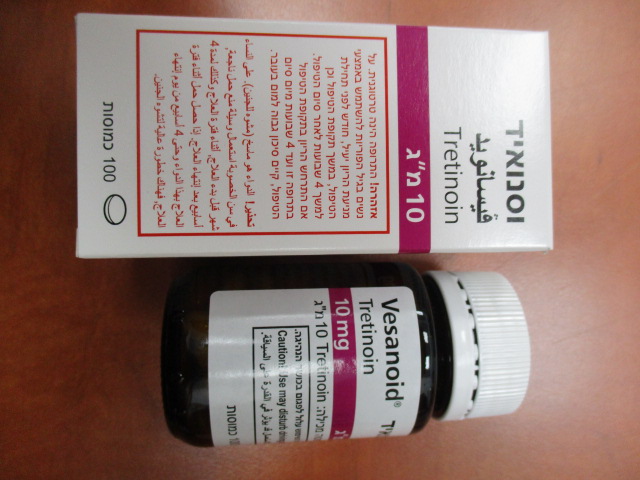Quest for the right Drug

וסנואיד VESANOID (TRETINOIN)
תרופה במרשם
תרופה בסל
נרקוטיקה
ציטוטוקסיקה
צורת מתן:
פומי : PER OS
צורת מינון:
קפסולות : CAPSULES
עלון לרופא
מינוניםPosology התוויות
Indications תופעות לוואי
Adverse reactions התוויות נגד
Contraindications אינטראקציות
Interactions מינון יתר
Overdose הריון/הנקה
Pregnancy & Lactation אוכלוסיות מיוחדות
Special populations תכונות פרמקולוגיות
Pharmacological properties מידע רוקחי
Pharmaceutical particulars אזהרת שימוש
Special Warning עלון לרופא
Physicians Leaflet
Adverse reactions : תופעות לוואי
4.8 Undesirable effects Summary of safety profile In patients treated with the recommended daily doses of tretinoin the most frequent undesirable effects are consistent with the signs and symptoms of the hypervitaminosis A syndrome (as for other retinoids). Tabulated list of adverse reactions The adverse reactions listed in the table below have been reported in pivotal clinical studies and during the post-marketing period. Adverse reactions are presented by MedDRA System Organ Class and frequency (very common (≥ 1/10)). Adverse reactions reported during the post-marketing period are also included in the table under the frequency category “not known” (cannot be estimated from the available data). System Organ Class Frequency Adverse Reaction(s) Infections and infestations Not known Necrotising fasciitis Blood and lymphatic Not known Thrombocytosis, leukocytosis, system disorders basophilia (with or without symptomatic hyperhistaminaemia) Metabolism and nutrition Very common Decreased appetite disorders Not known Hypercalcaemia Psychiatric disorders Very common Confusional state, anxiety, depression, insomnia Nervous system disorders Very common Headache, intracranial pressure increased, pseudotumour cerebri, dizziness, paraesthesia Not known Cerebrovascular accident Eye disorders Very common Visual disturbances, conjunctival disorders Ear and labyrinth Very common Hearing impaired disorders Cardiac disorders Very common Arrhythmia Not known Myocardial infarction, myocarditis, pericarditis Vascular disorders Very common Flushing Not known Arterial thrombosis, venous thrombosis involving various sites (e.g. cerebrovascular accident, myocardial infarction, renal infarct), vasculitis Respiratory, thoracic and Very common Respiratory failure, nasal dryness, mediastinal disorders asthma Gastrointestinal disorders Very common Dry mouth, nausea, vomiting, abdominal pain, diarrhoea, constipation, pancreatitis, cheilitis Skin and subcutaneous Very common Erythema, rash, pruritus, alopecia, tissue disorders hyperhidrosis Not known Erythema nodosum, acute febrile neutrophilic dermatosis (Sweet’s syndrome) Musculoskeletal and Very common Bone pain connective tissue Not known Myositis disorders Renal and urinary Not known Renal infarct disorders Reproductive system and Not known Genital ulceration breast disorders General disorders and Very common Chest pain, chills, malaise administration site conditions Investigations Very common Blood triglyceride increased, blood creatinine increased, blood cholesterol increased, transaminases increased Not known Histamine level increased The decision to interrupt or continue therapy should be based on an evaluation of the benefit of the treatment versus the severity of the side-effects. Description of selected adverse reactions Differentiation syndrome (formerly known as retinoic acid syndrome) may be fatal and is characterised by fever, dyspnoea, acute respiratory distress, pulmonary infiltrates, pleural and pericardial effusions, hypotension, oedema, weight gain, hepatic, renal and multi-organ failure. Differentiation syndrome is frequently associated with hyperleukocytosis. For prevention and treatment of differentiation syndrome see section 4.4. Leukocytosis/hyperleukocytosis are frequent adverse effects associated with tretinoin therapy of APL and may be accompanied by differentiation syndrome. However, most cases of leukocytosis/hyperleukocytosis are not associated with differentiation syndrome. In clinical trials, increased frequencies of hyperleukocytosis, QTc prolongation and hepatotoxic effects have been observed with combination therapy of tretinoin with arsenic trioxide compared to combination therapy of tretinoin with chemotherapy. Liver toxicity occurred predominantly during the first phase of therapy (induction therapy) and is mainly characterised by increase in transaminases. For the characteristics, prevention, and treatment of hyperleukocytosis, QTc prolongation and hepatotoxic effects see section 4.4. Teratogenicity: See section 4.6. Paediatric population There is limited safety information on the use of tretinoin in children. There have been some reports of increased toxicity in children treated with tretinoin, particularly increased pseudotumour cerebri (see section 4.4). Reporting suspected adverse reactions Reporting suspected adverse reactions after authorisation of the medicinal product is important. It allows continued monitoring of the benefit/risk balance of the medicinal product. Any suspected adverse events should be reported to the Ministry of Health according to the National Regulation by using an online form https://sideeffects.health.gov.il/

פרטי מסגרת הכללה בסל
א. התרופה תינתן לטיפול בלוקמיה פרומילוציטית חריפה ב. מתן התרופה האמורה ייעשה לפי מרשם של מומחה באונקולוגיה, רופא מומחה בהמטולוגיה או רופא מומחה בגינקולוגיה המטפל באונקולוגיה גינקולוגית.
מסגרת הכללה בסל
התוויות הכלולות במסגרת הסל
| התוויה | תאריך הכללה | תחום קליני | Class Effect | מצב מחלה |
|---|---|---|---|---|
| התרופה תינתן לטיפול בלוקמיה פרומילוציטית חריפה | 01/01/2000 |
שימוש לפי פנקס קופ''ח כללית 1994
לא צוין
תאריך הכללה מקורי בסל
01/01/2000
הגבלות
תרופה מוגבלת לרישום ע'י רופא מומחה או הגבלה אחרת
מידע נוסף
